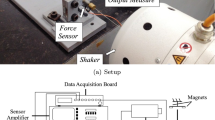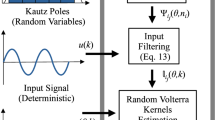Abstract
The Volterra series is a well-known method of describing non-linear dynamic systems. A major limitation of this technique is the difficulty involved in the calculation of the kernels. More recently, artificial neural networks have been used to produce black box models of non-linear dynamic systems. In this paper we show how a certain class of artificial neural networks are equivalent to Volterra series and give the equation for the nth order Volterra kernel in terms of the internal parameters of the network. The technique is then illustrated using a specific non-linear system. The kernels obtained by the method described in the paper are compared with those obtained by a Toeplitz matrix inversion technique.
Similar content being viewed by others
References
Aertsen AMHJ, Johannesma PIM (1981) The spectro-temporal receptive field: a functional characteristic of auditory neurons. Biol Cybern 42:133–143
Boer E de, Kuyper P (1968) Triggered correlation. IEEE Trans Biomed Eng 15:169–179
Chakraborty K, Mehrotra K, Mohan CK, Ranka S (1992) Forecasting the behavior of multivariate time series using neural networks. Neural Networks 5:961–970
Cheney EW (1982) Introduction to approximation theory, 2nd edn. Chelsea, New York
Cybenko G (1989) Approximation by superpositions of sigmoidal functions. Math Control Signals Syst 2:303–314
Emerson RC, Korenberg MJ, Citron MC (1992) Identification of complex-cell intensive nonlinearities in a cascade model of cat visual cortex. Biol Cybern 66:291–300
Fliess M, Lamnabhi M, Lamnabhi-Lagarrigue F (1983) An algebraic approach to nonlinear functional expansions. IEEE Trans Circuits Syst 30:554–570
Funahashi K (1989) On the approximate realization of continuous mapping by neural networks. Neural Networks 2:183–192
Hartman E, Keeler JD (1991) Predicting the future: advantages of semilocal units. Neural Comput 3:566–578
Hearne PG, Wray J, Sanders DJ, Agar E, Green GGR (1993) The neurone as a nonlinear system: a single compartment study. In: Eeckman FH, Bower JM (eds) Computation and neural systems. Kluwer, Norwell, pp. 19–23
Hearne PG, Manchanda S, Janahmadi M, Thompson IM, Wray J, Sanders DJ, Green GGR (1994) Solutions to Hodgkin-Huxley equations: functional analysis of a molluscan neurone. In: Eeckman FH, Bower JM (eds) Computation and neural systems. II. Kluwer, Norwell
Hertz J, Krogh A, Palmer R (1990) Introduction to the theory of neural computation. Addison-Wesley, Redwood
Hornik K, Stinchcombe M, White H (1989) Multilayer feedforward networks are universal approximators. Neural Networks 2:359–366
Hudson JL, Kube M, Adomatis RA, Kevrekidis IG, Lapedes AS, Farber RM (1990) Nonlinear signal processing and system identification: applications to time series from electrochemical reactions. Chem Eng Sci 45:2075–2081
Knuth DE (1981) Seminumerical algorithms. (Art of computer programming, Vol 2). Addison-Wesley, Redwood
Korenberg MJ, Hunter IW (1990) The identification of nonlinear biological systems: Wiener kernel approaches. Ann Biomed Eng 18:629–654
Lambert JM, Hecht-Nielsen R (1991) Application of feedforward and recurrent neural networks to chemical plant predictive modeling. In: Proceedings of International Joint Conference on Neural Networks Seattle, pp I373–I378
Lee YW, Schetzen M (1965) Measurement of the Wiener kernels of a nonlinear system by cross-correlation. Int J Control 2:237–254
Lippmann RP (1987) An introduction to computing with neural nets. IEEE ASSP Magazine April:4–22
Marmarelis PZ, Marmarelis VZ (1978) Analysis of physiological systems: the white noise approach. Plenum Press, New York
Marmarelis PZ, Naka K (1972) White-noise analysis of a neurone chain: an application of the Wiener theory. Science 175:1276–1278
Mizunami M, Tateda H, Naka K (1986) Dynamics of cockroach ocellar neurons. J Gen Physiol 88:275–292
Moody J, Darken CJ (1989) Fast learning in networks of locally-tuned processing units. Neural Comput 1:281–294
Nabet B, Pinter RB (1992) Multiplicative inhibition and Volterra series expansion. In: Pinter RB, Nabet B (eds) Nonlinear vision: determination of neural receptive fields, function and networks. CRC Press, Boca Raton, pp 475–492
Palm G, Poggio T (1977) The Volterra representation and the Wiener expansion: validity and pitfalls. SIAM J Appl Math 33:195–216
Palm G, Pöppel B (1985) Volterra representation and Wiener-like identification of nonlinear systems: scope and limitations. Q Rev Biophys 18:135–164
Poggio T, Reichardt W (1973) Considerations on models of movement detection. Kybernetik 13:223–227
Rugh WJ (1981) Nonlinear system theory: the Volterra/Wiener approach. Johns Hopkins University Press, Baltimore
Rumelhart DE, McCelland JL, PDP Research Group (1986) Parallel distributed processing: explorations in the microstructure of cognition, Vol 1. MIT Press, Cambridge, Mass
Schetzen M (1965) Measurement of the kernels of a non-linear system of finite order. Int J Control 1:251–263
Schetzen M (1980) The Volterra and Wiener theories of nonlinear systems. Wiley, New York
Volterra V (1959) Theory of functionals and integral and integro-differential equations. Dover, New York
Waibel A, Hanazawa T, Hinton G, Shikano K, Lang K (1989) Phoneme recognition using time-delay neural networks. IEEE Trans Acoustics Speech Signal Process 37:328–339
Weigend AS, Huberman BA, Rumelhart DE (1990) Predicting the future: a connectionist approach. Int J Neural Syst 1:193–209
Wiener N (1958) Nonlinear problems in random theory. MIT Press, Cambridge, Mass
Wolfram S (1988) Mathematica: a system for doing mathematics by computer. Addison-Wesley, Redwood
Wray J (1992) Theory and applications of neural networks. PhD thesis, University of Newcastle upon Tyne, UK
Wray J, Green GGR (1991) Analysis of networks that have learnt control problems. In: Proceedings of IEEE Control-91. Herriot-Watt, UK, pp 261–265
Author information
Authors and Affiliations
Rights and permissions
About this article
Cite this article
Wray, J., Green, G.G.R. Calculation of the Volterra kernels of non-linear dynamic systems using an artificial neural network. Biol. Cybern. 71, 187–195 (1994). https://doi.org/10.1007/BF00202758
Received:
Accepted:
Issue Date:
DOI: https://doi.org/10.1007/BF00202758




